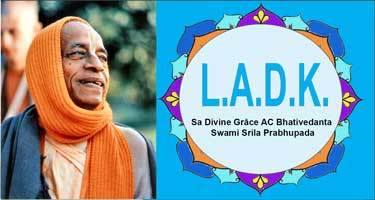
These texts below show why the Srimad Bhagavatam is the ripened fruit of all Vedic knowledge These few verses were spoke by the great Jada Bharata to King Rahugana
SB 5.12.10-Since this universe has no real ultimate existence, the things within it—shortness, differences, grossness, skinniness, smallness, bigness, result, cause, living symptoms, and materials—are all imagined. They are all pots made of the same substance, earth, but they are named differently. The differences are characterized by the substance, nature, predisposition, time and activity. You should know that all these are simply mechanical manifestations created by material nature.
SB 5.12.11-What, then, is the ultimate truth? The answer is that nondual knowledge is the ultimate truth. It is devoid of the contamination of material qualities. It gives us liberation. It is the one without a second, all-pervading and beyond imagination. The first realization of that knowledge is Brahman. Then Paramātmā, the Supersoul, is realized by the yogīs who try to see Him without grievance. This is the second stage of realization. Finally, full realization of the same supreme knowledge is realized in the Supreme Person. All learned scholars describe the Supreme Person as Vāsudeva, the cause of Brahman, Paramātmā and others.
PURPORT-In Caitanya-caritāmṛta it is said: yad advaitaṁ brahmopaniṣadi tad apy asya tanu-bhā. The impersonal Brahman effulgence of the Absolute Truth consists of the bodily rays of the Supreme Personality of Godhead. Ya ātmāntaryāmī puruṣa iti so ’syāṁśa-vibhavaḥ. What is known as ātmā and antaryāmī, the Supersoul, is but an expansion of the Supreme Personality of Godhead. Sad-aiśvaryaiḥ pūrṇo ya iha bhagavān sa svayam ayam [Cc. Ādi 1.3]. What is described as the Supreme Personality of Godhead, complete with all six opulences, is Vāsudeva, and Śrī Caitanya Mahāprabhu is nondifferent from Him. Great learned scholars and philosophers accept this after many, many births. Vāsudevaḥ sarvam iti sa mahātmā sudurlabhaḥ (Bg. 7.19). The wise man can understand that ultimately Vāsudeva, Kṛṣṇa, is the cause of Brahman, and Paramātmā, the Supersoul. Thus Vāsudeva is sarva-kāraṇa-kāraṇam [Bs. 5.1], the cause of all causes. This is confirmed in Śrīmad-Bhāgavatam. The real tattva, Absolute Truth, is Bhagavān, but due to incomplete realization of the Absolute Truth, people sometimes describe the same Viṣṇu as impersonal Brahman or localized Paramātmā.
vadanti tat tattva-vidas tattvaṁ yaj jñānam advayam brahmeti paramātmeti bhagavān iti śabdyate (Bhāg. 1.2.11)
From the very beginning, Śrīmad-Bhāgavatam says, satyaṁ paraṁ dhīmahi: we meditate on the supreme truth. The supreme truth is explained here as jñānaṁ viśuddhaṁ satyam. The Absolute Truth is devoid of material contamination and is transcendental to the material qualities. It gives all spiritual success and liberation from this material world. That Supreme Absolute Truth is Kṛṣṇa, Vāsudeva. There is no difference between Kṛṣṇa’s inner self and outward body. Kṛṣṇa is pūrṇa, the complete whole. There is no distinction between His body and soul as there is between ours. Sometimes so-called scholars, not knowing the constitutional position of Kṛṣṇa, mislead people by saying that the Kṛṣṇa within is different from the Kṛṣṇa without. When Kṛṣṇa says, man-manā bhava mad-bhakto mad-yājī māṁ namaskuru, so-called scholars advise the reader that it is not the person Kṛṣṇa to whom we must surrender but the Kṛṣṇa within. So-called scholars, Māyāvādīs, cannot understand Kṛṣṇa with their poor fund of knowledge. One should therefore approach an authorized person to understand Kṛṣṇa. The spiritual master has actually seen Kṛṣṇa; therefore he can explain Him properly.
tad viddhi praṇipātena paripraśnena sevayā upadekṣyanti te jñānaṁ jñāninas tattva-darśinaḥ (Bg. 4.34)
Without approaching an authorized person, one cannot understand Kṛṣṇa.
SB 5.12.12-My dear King Rahūgaṇa, unless one has the opportunity to smear his entire body with the dust of the lotus feet of great devotees, one cannot realize the Absolute Truth. One cannot realize the Absolute Truth simply by observing celibacy [brahmacarya], strictly following the rules and regulations of householder life, leaving home as a vānaprastha, accepting sannyāsa, or undergoing severe penances in winter by keeping oneself submerged in water or surrounding oneself in summer by fire and the scorching heat of the sun. There are many other processes to understand the Absolute Truth, but the Absolute Truth is only revealed to one who has attained the mercy of a great devotee.
PURPORT-Actual knowledge of transcendental bliss can be bestowed upon anyone by a pure devotee. Vedeṣu durlabham adurlabham ātma-bhaktau [Bs. 5.33]. One cannot attain the perfection of spiritual life simply by following the directions of the Vedas. One has to approach a pure devotee: anyābhilāṣitā-śūnyaṁ jñāna-karmādy-anāvṛtam [Madhya 19.167]. By the grace of such a devotee, one can understand the Absolute Truth, Kṛṣṇa, and one’s relationship with Him. A materialistic person sometimes thinks that simply by executing pious activities and remaining at home one can understand the Absolute Truth. That is denied in this verse. Nor can one understand the Absolute Truth simply by observing the rules and regulations of brahmacarya (celibacy). One only has to serve the pure devotee. That will help one understand the Absolute Truth without fail
The Three phases of Spiritual Realization
SB 4.30.31 purport--
The Supreme Personality of Godhead is parataḥ parāt. The word para means “transcendental, beyond this material world.” The impersonal Brahman effulgence is beyond this material world, and this is called paraṁ padam. Āruhya kṛcchreṇa paraṁ padam (Bhāg. 10.2.32). Merging into the impersonal effulgence of the Lord is called paraṁ padam, but there is a higher transcendental position, which is the association of the Supreme Personality of Godhead. Brahmeti paramātmeti bhagavān iti śabdyate (Bhāg. 1.2.11). The Absolute Truth is realized first as impersonal Brahman, then as Paramātmā, and finally as Bhagavān. Thus the Personality of Godhead, Bhagavān, is parataḥ parāt, beyond Brahman and Paramātmā realization.
June 19 1974 Germany--This is a material example. Similarly, self-realization is ultimately, as I taught you, that, first impersonal Brahman, then localized Paramātmā, and then the yogis, they realize the localized Paramātmā. Dhyānāvasthita-tad-gatena manasā paśyanti yaṁ yoginaḥ [SB 12.13.1]. The yogis, they observe the Supersoul within himself, and they meditate upon Him.
Compiled by Damaghosa das

